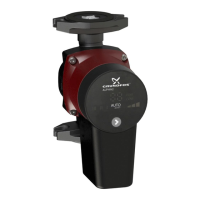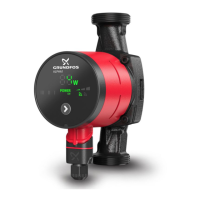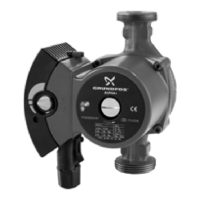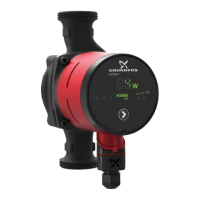English (GB)
16
7.8 Pump performance
Relation between pump setting and pump performance
Figure 28 shows the relation between pump setting and pump
performance by means of curves. See also section
11. Performance curves.
Fig. 28 Pump setting in relation to pump performance
TM05 2771 0512
III
II
I
H
PP3
CP3
CP2
PP1
CP1
PP2
Setting Pump curve Function
AUTO
ADAPT
factory
setting
Highest to lowest
proportional-pressure
curve
The AUTO
ADAPT
function enables the pump to control the pump performance automatically
within a defined performance range. See fig. 28.
• Adjusting the pump performance to the size of the system.
• Adjusting the pump performance to the variations in load over time.
In AUTO
ADAPT
, the pump is set to proportional-pressure control.
PP1
Lowest
proportional-pressure
curve
The duty point of the pump will move up or down on the lowest proportional-pressure curve,
depending on the heat demand. See fig. 28.
The head is reduced at falling heat demand and increased at rising heat demand.
PP2
Intermediate
proportional-pressure
curve
The duty point of the pump will move up or down on the intermediate proportional-pressure
curve, depending on the heat demand. See fig. 28.
The head is reduced at falling heat demand and increased at rising heat demand.
PP3
Highest
proportional-pressure
curve
The duty point of the pump will move up or down on the highest proportional-pressure curve,
depending on the heat demand. See fig. 28.
The head is reduced at falling heat demand and increased at rising heat demand.
CP1
Lowest
constant-pressure
curve
The duty point of the pump will move out or in on the lowest constant-pressure curve, depending
on the heat demand in the system. See fig. 28.
The head is kept constant, irrespective of the heat demand.
CP2
Intermediate
constant-pressure
curve
The duty point of the pump will move out or in on the intermediate constant-pressure curve,
depending on the heat demand in the system. See fig. 28.
The head is kept constant, irrespective of the heat demand.
CP3
Highest
constant-pressure
curve
The duty point of the pump will move out or in on the highest constant-pressure curve, depending
on the heat demand in the system. See fig. 28.
The head is kept constant, irrespective of the heat demand.
III Speed III
The pump runs on a constant curve which means that it runs at a constant speed.
In speed III, the pump is set to run on the maximum curve under all operating conditions. See fig.
28.
You obtain quick venting of the pump by setting the pump to speed III for a short period. See
section 5.2 Venting the pump.
II Speed II
The pump runs on a constant curve which means that it runs at a constant speed.
In speed II, the pump is set to run on the intermediate curve under all operating conditions. See
fig. 28.
I Speed I
The pump runs on a constant curve which means that it runs at a constant speed.
In speed I, the pump is set to run on the minimum curve under all operating conditions. See fig.
28.
Automatic night
setback or manual
summer mode
The pump changes to the curve for automatic night setback, i.e. absolute minimum performance
and power consumption, provided that certain conditions are met. In manual summer mode, the
pump is stopped to save energy and only the electronics are running. To avoid liming and
blocking of the pump, the pump is started frequently in a short period. See section 9. Fault
finding.

